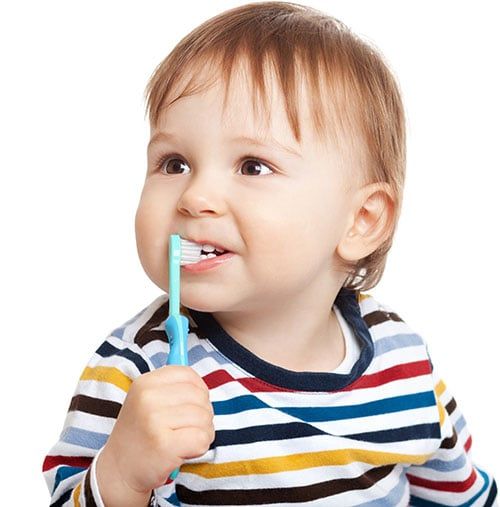Prevention Dentistry
Brushing
Step 1 - Place bristles along the gum line at a 45 degree angle. Gently brush using a circular motion along the outer and inner tooth surfaces.
Step 2 - Brush each tooth individually. Tilt brush vertically behind the front teeth. Using the front half of the brush, use the same circular motion.
Step 3 - Place the brush against the biting surface of the teeth and use a gentle back-and-forth motion. Brush the tongue to remove odor-producing bacteria.
Flossing
Flossing removes bits of food and any plaque build-up that is caught or stuck in the tight spaces between teeth and just below the gumline where a toothbrush cannot easily reach. Proper daily flossing combined with regular brushing is one of the easiest things you can do to prevent cavities and gum disease.
Floss is cheap, so don't be stingy. Wind about 18 inches of floss evenly around each of your middle fingers until one to two inches of floss is left between the two finders. Using your thumbs and index fingers, firmly grip the floss and slide the floss between your teeth. Curve the floss around the base of your tooth while using a gentle up-and-down motion, remove food particles and any plaque build-up between the two teeth. Take special note to make sure the floss reaches just below the gumline to ensure proper and thorough cleaning.
Repeat this step for all of your teeth and unwind a clean section of floss between your fingers as you move between teeth.
NEVER "saw" at your gums with dental floss or force the floss between teeth as this can damage gum tissue and be extremely painful.
Fluoride for Children
Fluoride, a substance that's found naturally in water, plays an important role in healthy tooth development and cavity prevention. Fluoride combats tooth decay in two ways:
- It strengthens tooth enamel, a hard and shiny substance that protects the teeth, so that it can better resist the acid formed by plaque.
- Fluoride allows teeth damaged by acid to repair, or re-mineralize, themselves.
Fluoride cannot repair cavities, but it can reverse low levels of tooth decay and thus prevent new cavities from forming.
The American Academy of Pediatrics recommends that these fluoride supplements be given daily to children between the ages of 6 months and 16 years. The dosage will change as your child grows. Only children living in non-fluoridated areas or children who drink only non-fluoridated bottled water should receive supplements.
Most children get the right amount of fluoride through a combination of fluoridated toothpaste and fluoridated water or supplements. Too much fluoride before 8 years of age can cause enamel fluorosis, a discoloration or mottling of the permanent teeth. This condition is unsightly but harmless and often can be treated with cosmetic procedures.

How Much Fluoride Is Too Much?
Fluoride is perfectly safe when used as directed by our dental office however there are some issues that can arise from using too much fluoride. Toxic levels of fluoride depend on person-to-person so it is important that you speak with us first before considering using a questionable amount of fluoride or if you have a child whose teeth are currently developing.
Fluorosis is a condition where exposure to too much fluoride causes defects in the tooth's enamel layer that often look like white patches or streaks across a tooth. In severe fluorosis cases, these patches or streaks can be brown in color making them a severe cosmetic concern and are often embarrassing for many people who have this condition. Fluorosis is most common in children with developing permanent teeth where fluoride levels are not properly applied and/or monitored but can become a problem to virtually anyone at any age.
If you think you have or have been told you have a mild to severe case of fluorosis, we want you to know that we can help lighten or remove the stains to teeth caused by excessive fluoride exposure. Request an appointment or call our office directly at (La Jolla) 858-455-7777, or (Chula Vista) 619-482-5555 to come in and have us take a look at your condition. In just one appointment we can significantly reduce the cosmetic blemishes of fluorosis.

Applying Dental Sealants
Sealants are one of the easiest preventive dental procedures that can be done. Sealing your teeth can be done in a single dental visit and is entirely painless!
We will first thoroughly clean and dry teeth that are going to be sealed. Generally, gauze and/or cotton will be placed around the tooth to prevent moisture collecting on the tooth. A clean and dry tooth is essential for the sealant material to properly adhere.
Next, a mild acid is applied to the chewing surface of the tooth. This will roughen the surface layer of the tooth's enamel and will provide an optimal surface for the sealant material to bond to.
The tooth will be rinsed with water and dried a final time before the sealant is placed.
Dental sealant material is a plastic-like material that is brushed onto the tooth's chewing services. This liquid-like material will sink into the nooks and crannies within the chewing surface and start bonding directly to the enamel layer of the tooth. We will use a special blue curing light that hardens the sealant.
That's it! Your tooth is now sealed off from harmful plaque and bacteria.
Schedule An Appointment
Life Smiles Dental Care would love to meet you and your family and provide you with the dental care you need and give you all smiles you deserve!



